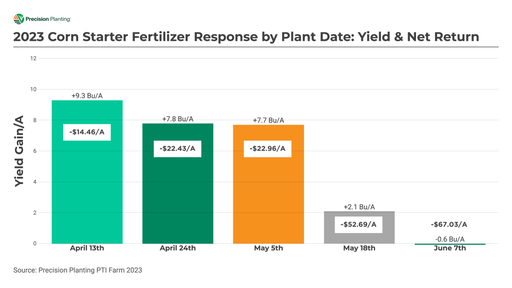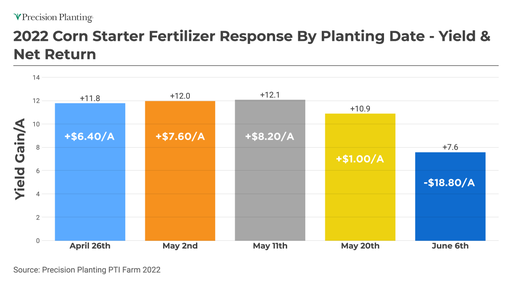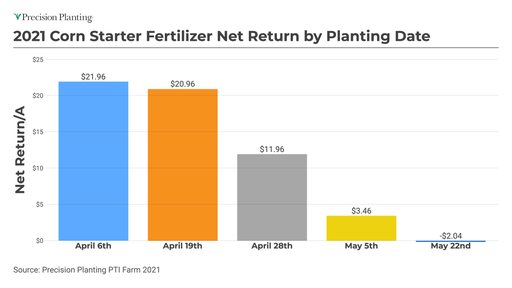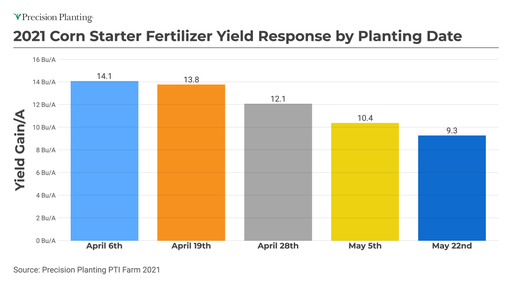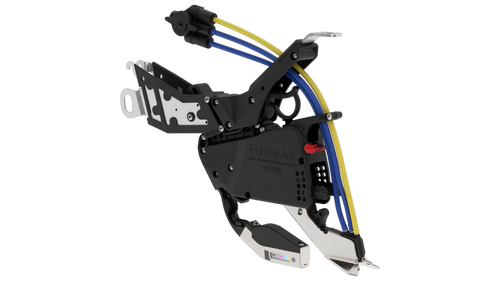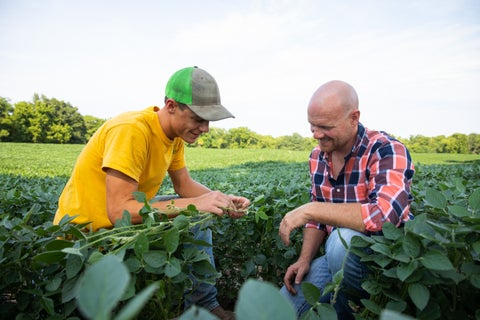Key Points
- Objective: The purpose of this study is to monitor the performance of starter fertilizer at various planting dates.
- Fertilizer Cost: The cost of fertilizer can impact overall ROI. In 2022, we showed several planting dates that returned minimal revenue gains and even a negative ROI due to the increased cost of starter fertilizer from the previous year. Starter fertilizers increased in price in 2022 by nearly 40% over the 2021 price! This trend extended even more heavily into 2023 as we didn't see any positive economic returns due to fertilizer cost.
- Colder Planting Dates: Our highest yield gain using starter fertilizer was 14.1 Bu/A. Generally, we saw our starter fertilizer program yield the best results when used during colder planting dates.
Does starter fertilizer respond differently at earlier planted dates or later planting dates?
When it comes to fertilizer, it’s easy to overspend your dollars on nutrients and not have what you need to cover both a full fall program dry fertilizer and a starter fertilizer at the time of planting.
The goal of any fertilizer program is to create a healthier root system to get a healthier plant which results in a higher yield. However, if the cost of your fertilizer program outpaces your projected revenue, you could end up with a negative return on investment.
With so many factors and fertilizer options, it’s important to analyze the potential ROI before you invest your dollars.
In this multi-year study at the PTI Farm, we are exploring how planting dates affect the ROI of utilizing a starter fertilizer. Outside of the latest planting date in 2023, we have found that every planting date has achieved yield gains from our starter fertilizer program, but that hasn't always led to economic increases. Generally, we we have seen our starter fertilizer program yield the best results when used during colder planting dates.
Our highest yield gain using starter fertilizer was 14.1 Bu/A in 2021. In 2023, yield gains averaged +5.3 Bu/A, ranging from -0.6 Bu/A to +9.3 Bu/A between all the planting dates, with the highest-performing planting date being April 13th. However, economics indicated negative return on investment for all planting dates, with losses ranging from -$14.46/A on the earliest planting date to -$67.03/A on the latest planting date. These disappointing revenue losses are the result of the ongoing high cost of fertilizer.
The primary takeaway from this study so far is to consider how a starter fertilizer program can benefit your early planting dates, especially once we see fertilizer return to a more normal cost. We wouldn’t recommend abandoning your fall fertilizer applications, but instead to consider splitting your dollars on nutrients between a fall fertilizer and starter fertilizer program together.
In-Depth Study Videos
InsidePTI S1•E42
Liquid Starter Fertilizer Rates
Study Details
Study data collected 2018-2023 at the PTI Farm in Pontiac, IL.
| Planting Date | Varied By Year | Rotation | CAB, CAC |
| Row Width | 20"-30" | Population | 24K-36K |
| Corn Prices | 2023: $5.31 2022: $6.00 2021: $5.00 2020: $3.75 2019: $3.67 2018: $3.50 | Hybrid | 2023: GH10L16 2022: GH11V78 2021: GH15J91 2020: GH10D21 2019: DKC 65-94 2018: Pioneer 1197AMXT |
